Completed 6th century | Architectural style Armenian Architecture | |
 | ||
Location Avan district, Yerevan, Armenia Affiliation Armenian Apostolic Church Architectural type Radiating (Hripsime); Inner octagon with cylindrical niches Dome(s) Thought to have had 5 (a single larger dome in the center, and 4 cupolas at each corner). Similar Katoghike Church - Yerevan, Yeghipatrush Church, Ptghnavank, Red Bridge - Yerevan, St Thaddeus Church | ||
Holy Mother of God Katoghike Church of Avan (Armenian: Ավանի Սուրբ Աստվածածին Կաթողիկե Եկեղեցի (Avani Surb Astvatsatsin Kat'oghike Yekeghets'i); also Katoghike Tsiranavor church, later renamed Surp Hovhannes) is a ruined 6th century church located in the Avan district of Yerevan, the capital of Armenia. It is the oldest surviving church inside Yerevan's city limits.
Contents
History
The church of Katoghike was built in the late 6th century, between the years 591 or 595-602, by the pro-Byzantine Catholicos Hovhannes Bagavanetsi as his headquarters. He was installed as prelate of Byzantine Armenia by the Byzantine emperor Mauricius. The headquarters of his rival, the pro-Persian Catholicos, was located in Dvin. Adjacent to the church on the north side are the foundations of the palatial residence of Catholicos Hovhannes, thought to have been constructed before the church around the years 581-582. According to the 7th-century Armenian historian Sebeos, both structures were built under the Catholicos' supervision. The church is believed to have been dedicated to the Apostles. In the year 602 the Persian King Khosrov II seized Avan, and having eliminated the Avanian Catholicos, transformed the complex into a monastery.
Architecture
Katoghike Church which would later be renamed Surp Hovhannes, was constructed upon what was the site of previous structures. Numerous ornamented stones found during excavations predominantly on the western side of the building confirm this notion. The remains of the structure sit on a two-stepped platform, while the church's vaults, domes, and roof are missing as well as portions of the upper walls. Architectural historian Toros Toramanian believed that the current roofless church once had five domes; a single larger dome in the center and four smaller cupolas over each corner of the church, above the circular corner chambers. If correct, Avan would be the first such example of a church with five cupolas. The church is quatrefoil in plan, with an octagonal central bay originally with a dome above. There are four semi-circular apses, and four three-quarter circle diagonal niches leading to circular chambers in the corners of the church. The circular shape of the side-chapels gives the church its unique design.
The front (west) façade has lengthy inscriptions on either side of the entry upon the top third of the building, and also on the lintel above the front door there is a short inscription. The name 'Yohan' can be found written within one of the inscriptions, possibly as an earlier style of the name of Hovhannes, but thought not to be of any reference to the Catholicos. A low arched doorway leads into the church from the western wall and is surrounded by an ornamented casing, three-quartered pillars, topped with capitals and lunettes. A vishap stone was used in the interior as the lintel above the main portal. At the north wall is another doorway thought to have been constructed at a later time, after the church was built, to lead to the palace of the Catholicos. Aside from the reasons previously mentioned, the church of S. Hovhannes is important architecturally because it is thought to have been a prototype of Saint Hripsime Church completed later in the year 618. Conservation work was done to the church in 1940-1941, and again in 1956-1966, and 1968.
